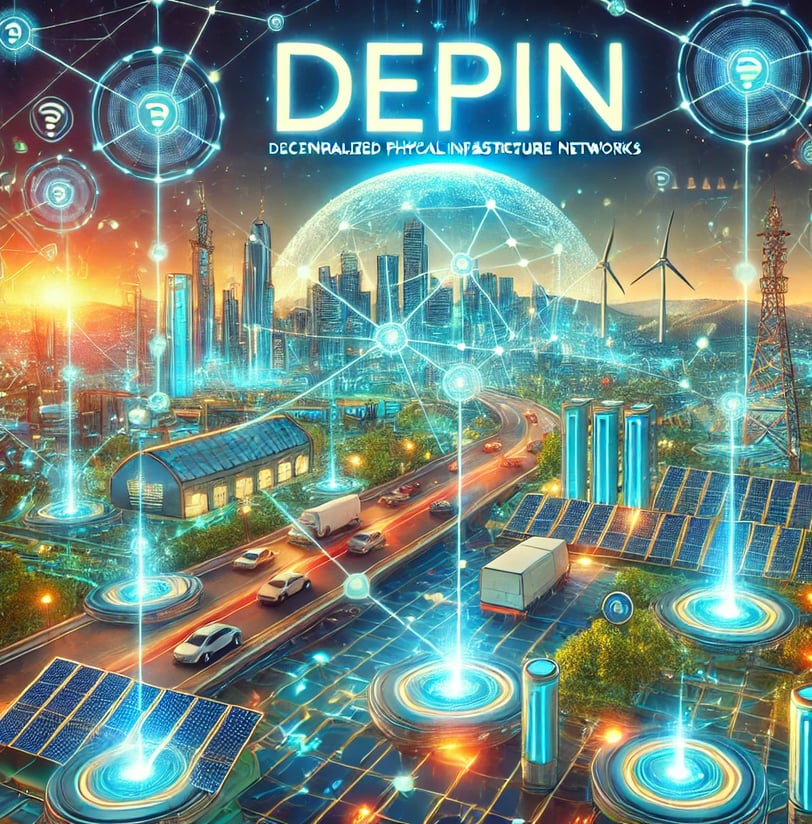The DEPIN Segment in the Cryptocurrency Market: Purpose, Necessity, Utility, Challenges, and Future
CRYPTO MARKET
1/17/20254 min read


The cryptocurrency market has been rapidly expanding, bringing innovations that challenge traditional economic, governance, and technological models. Within this ecosystem, the DEPIN segment (Decentralized Physical Infrastructure Networks) emerges as one of the most promising, combining physical and digital resources to address real market needs.
Purpose of DEPIN
Decentralized Physical Infrastructure Networks aim to create and maintain shared, collectively managed infrastructures. In a context where physical resources such as charging stations for electric vehicles, wireless communication networks, and IoT sensors are in constant demand, DEPIN seeks to offer decentralized solutions for managing and utilizing these assets.
The core idea is to leverage blockchain technology to record transactions, smart contracts, and rewards transparently and securely. This allows individuals and organizations to collaborate in building robust infrastructures without the need for centralized intermediaries.
Necessity of DEPIN in the Current Market
The demand for decentralized solutions directly reflects problems faced by traditional models. Some of the main needs driving the DEPIN segment include:
Efficiency and Cost Reduction: Centralized networks often incur high operational costs, bureaucracy, and inefficiency. DEPIN offers a more agile and economical approach, eliminating intermediaries.
Transparency and Reliability: By using blockchain technology, DEPIN provides an immutable record of all activities and transactions, fostering trust among participants.
Democratization of Access: Many emerging markets suffer from a lack of infrastructure. DEPIN enables individuals in remote regions to access essential services, such as connectivity and energy, more affordably.
Sustainability: Decentralized management encourages efficient resource use, contributing to sustainable and eco-friendly solutions.
Utility of DEPIN in the Cryptocurrency Market
DEPIN applications span various areas, with notable highlights in:
Telecommunications: Decentralized networks like Helium use connected devices to create peer-to-peer (P2P) communication infrastructures. These networks provide broader coverage and reduced costs compared to traditional providers.
Energy: Solutions like decentralized solar energy distribution allow individuals to generate and trade electricity directly, using tokens to track and settle transactions.
Internet of Things (IoT): Sensors and connected devices generate crucial data for services like environmental monitoring, logistics, and security. DEPIN enables the efficient use of these devices in decentralized networks.
Urban Mobility: Infrastructures such as charging stations for electric vehicles and bike-sharing systems can be managed in a decentralized manner, promoting shared use and reducing congestion.
Decentralized Finance (DeFi): DEPIN can integrate with DeFi to enable collaborative financing of infrastructures, using tokens as currency for exchange and incentives.
Major Cryptocurrencies and Ecosystems in the DEPIN Market
Several cryptocurrencies lead the DEPIN segment, representing robust ecosystems with different use cases. Among the most notable are:
Helium (HNT): Helium is one of the leading DEPIN projects, focusing on creating decentralized networks for the Internet of Things (IoT). The network uses hotspots that reward users with HNT tokens for providing coverage and data to the network. This model has been successful in creating a broad and accessible communication infrastructure.
Filecoin (FIL): Filecoin is a decentralized data storage protocol. It allows individuals to rent unused storage space on their devices and be rewarded in FIL. Transparency and censorship resistance make Filecoin one of the most relevant projects in the decentralized infrastructure segment.
Chainlink (LINK): While better known for its decentralized oracles, Chainlink is also essential for integrating real-world data with smart contracts. Its utility in supporting decentralized physical infrastructure networks makes LINK a crucial asset.
Energy Web Token (EWT): Energy Web Token is designed to facilitate the transition to decentralized and sustainable energy systems. The project enables energy consumers and producers to interact directly, promoting clean energy solutions.
The Graph (GRT): The Graph is a decentralized infrastructure that indexes and queries blockchain data, allowing developers to build more efficient decentralized applications. Its integration with various protocols makes it a solid foundation for DEPIN projects.
Disclaimer: This text is for informational and educational purposes only and does not constitute investment advice. Before investing in any cryptocurrency, conduct your own analysis and consult a qualified financial professional.
These cryptocurrencies play crucial roles in building decentralized infrastructures, each focusing on solving specific problems in the DEPIN market.
Challenges of DEPIN
Despite its significant potential, the DEPIN segment faces several challenges:
Scalability: Decentralized networks must handle an increasing volume of data and transactions, which can compromise performance.
Regulation: Many countries still lack clear legislation on blockchain and cryptocurrency use, creating uncertainties for DEPIN projects.
Security: Like any digital technology, these networks are susceptible to cyberattacks and vulnerabilities.
Adoption: Limited understanding of how decentralized networks and blockchain work can hinder mass adoption.
Interoperability: Integrating decentralized networks with traditional systems or other blockchains remains a significant challenge.
The Future of DEPIN
The prospects for the DEPIN segment are promising, with technological advances and a better understanding of its positive impact. Some points indicating the sector's future include:
Integration with AI and Machine Learning: Utilizing artificial intelligence to optimize processes such as resource distribution and network security.
Growth of Local Communities: Decentralized models allow local communities to create and manage their own infrastructures, promoting autonomy.
Public-Private Collaboration: Governments and private companies can explore DEPIN to develop scalable and sustainable solutions.
Asset Tokenization: Using tokens to represent and trade physical infrastructure will open new markets and investment opportunities.
Global Expansion: The spread of DEPIN projects in underdeveloped regions can create significant social impact, promoting digital and economic inclusion.
The DEPIN segment represents a revolution in how physical infrastructures are conceived, implemented, and managed. By combining blockchain transparency and security with the need for decentralized solutions, DEPIN offers a promising path toward a more efficient, accessible, and sustainable future.
Although challenges are significant, opportunities outweigh barriers, making DEPIN a key growth and innovation area in the cryptocurrency market. With technological advances and broader global adoption, Decentralized Physical Infrastructure Networks have the potential to profoundly transform the world we live in.
